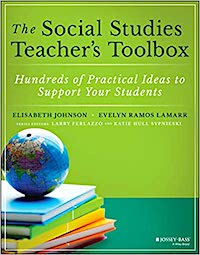Teach Current Events as ‘History in the Making’
MiddleWeb is featuring excerpts from three new books edited by the editorial team of Larry Ferlazzo and Katie Hull Sypnieski, both teachers in Sacramento CA and co-authors of The ELL Teacher’s Toolbox. This week we’re sharing an excerpt from The Social Studies Teacher’s Toolbox. Also see: The The Math Teacher’s Toolbox and The Science Teacher’s Toolbox.
By Elisabeth Johnson and Evelyn Ramos
The social studies classroom is an obvious place to examine current events. This kind of study – highlighting “history in the making” – can help students recognize that events don’t occur in a vacuum and that there are causes and effects that may be seen or unseen.
The study of current events also increases relevance. It helps students see connections between the content, themselves, and the world around them. Bringing current events into the social studies classroom can have multiple benefits including increased engagement and academic performance.
Quick current events ideas
There are many ways to include current events in social studies. Here are a few ideas:
► Weekly Article – At the beginning of the week, present students with an article on a current event. Students are assigned the article as their weekly reading. Then they are instructed to make a connection between the reading and the topics being studied in class. Students write a brief summary of the connection between the two and turn it in as an assignment.
► Article Blizzard – Students are given a current event topic and instructed to find articles from a variety of sources, thus generating a “blizzard” of information. Students analyze their article and place it on a media bias chart, highlighting details they believe show evidence of bias.
► Write the Headline – Students are given an article on a current event with the headline removed. After reading the article, students are instructed to create an eye-catching headline and lead that preview the main events of the story.
► Daily News – Show a brief news clip(s) of a current event. Some news outlets even have daily news segments like Cable News Network (CNN), which has a program called CNN 10. These 10-minute segments are followed by a weekly news quiz provided on Fridays. In addition to watching these daily clips, we always have students respond to a question afterward. Then we call on a few students to share with the class.

► Making Connections – Students are challenged to find a current news article that they can connect to the topic they are studying in their history, government, geography, or economics class. They then have to summarize the event and explain its connection. As in all assignments, showing a teacher model first will result in greater student understanding.
► Explainer Videos – Many news outlets create short videos simply explaining current events. Students can be challenged to create their own versions.. Many examples can be found in Larry Ferlazzo’s blog post “The Best Online ‘Explainer’ Tools for Current Events”.
► Predictions – Students can choose articles on current events and predict what they believe will happen next and, most importantly, why they believe their prediction could be accurate.
Sharpening research skills and raising awareness of bias
A focus on current events can also be a good opportunity to help develop research skills and introduce bias awareness as well as other components of information literacy.
Our students need to be taught how to carefully consume information, checking for “fake news,” bias, e-safety, and ethical issues, among other skills. To this end, a few activities to help students improve their information literacy may include:
► Give students a guide or criteria to help them check for the validity of a news story. The Public Broadcasting System (PBS) has a good video on Identifying “Fake” News from Common Sense Media (Identifying “Fake” News, n.d.). There is also a printable one-page guide from On The Media called the Breaking News Consumer’s Handbook (n.d.). Both of these sources, and others available online, can help students recognize potential biases in news stories. After reviewing key criteria in small groups and as a class, students can identify one-to-three news stories of their choice and evaluate each one based on what they learned.

► Introduce students to a website like the Poynter Institute’s Politifact, which allows them to check the validity of stories they may have seen online using the Truth-o-Meter. Students can search for stories by topic or by inputting key terms into a search engine.
If we are serious about assisting our students to become informed and active citizens in society, we must look for opportunities to use current events to promote critical thinking and improve information literacy.

Evelyn Ramos, an Area 3 Writing Project Teacher Consultant with a Masters in Education, has taught a mix of social studies classes at Luther Burbank High for the past 12 years.
They are the authors of The Social Studies Teacher’s Toolbox: Hundreds of Practical Ideas To Support Your Students.(Jossey Bass, 2020)





































Good work, may you send more